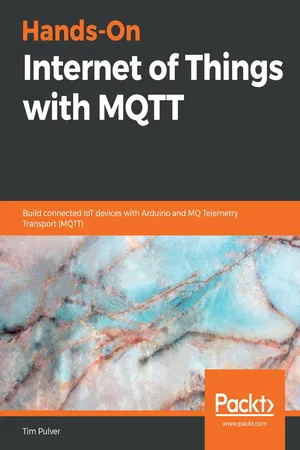
Hands-On Internet of Things with MQTT
Build connected IoT devices with Arduino and MQ Telemetry Transport (MQTT)
- 350 pages
- English
- ePUB (mobile friendly)
- Available on iOS & Android
Hands-On Internet of Things with MQTT
Build connected IoT devices with Arduino and MQ Telemetry Transport (MQTT)
About This Book
Develop a variety of projects and connect them to microcontrollers and web servers using the lightweight messaging protocol MQTT
Key Features
- Leverage the power of MQTT to build a pet food dispenser, e-ink to-do list, and a productivity cube
- Learn about technologies like laser cutting, 3D printing, and PCB production for building robust prototypes
- Explore practical uses cases to gain an in-depth understanding of MQTT
Book Description
MQ Telemetry Transport (MQTT) is a lightweight messaging protocol for smart devices that can be used to build exciting, highly scalable Internet of Things (IoT) projects.
This book will get you started with a quick introduction to the concepts of IoT and MQTT and explain how the latter can help you build your own internet-connected prototypes. As you advance, you'll gain insights into how microcontrollers communicate, and you'll get to grips with the different messaging protocols and techniques involved. Once you are well-versed with the essential concepts, you'll be able to put what you've learned into practice by building three projects from scratch, including an automatic pet food dispenser and a smart e-ink to-do display. You'll also discover how to present your own prototypes professionally. In addition to this, you'll learn how to use technologies from third-party web service providers, along with other rapid prototyping technologies, such as laser cutting, 3D printing, and PCB production.
By the end of this book, you'll have gained hands-on experience in using MQTT to build your own IoT prototypes.
What you will learn
- Explore MQTT programming with Arduino
- Discover how to make your prototypes talk to each other
- Send MQTT messages from your smartphone to your prototypes
- Discover how you can make websites interact with your prototypes
- Learn about MQTT servers, libraries, and apps
- Explore tools such as laser cutting and 3D printing in order to build robust prototype cases
Who this book is for
If you are an IoT developer or enthusiast who wants to start building IoT prototypes using MQTT, this book is for you. Basic knowledge of programming with Arduino will be useful.
Frequently asked questions
Information
Section 1: An Introduction to IoT and MQTT
- Chapter 1, The Internet of Things in a Nutshell
- Chapter 2, Basic Architecture of an IoT Prototype
- Chapter 3, Getting Started with MQTT
The Internet of Things in a Nutshell
- Exploring smart homes
- Exploring smart cars
- Exploring industry 4.0 / the Industrial Internet of Things
- Prototyping for the greater good
- What is a prototype?
- Voice control
- Why should you invest in the IoT?
Exploring smart homes
- Smart fridges
- Smart door locks
- Smart thermostats
- Smart scales
- Smart lights
- Smart pet food dispensers
- Food goes to waste because you have no clear overview of expiration dates for each item.
- You run out of a certain food because you did not keep track of your supply.
How smart devices connect to the internet
- You connect the smart device to a power source.
- The smart device goes into setup mode.
- The smart device opens an ad hoc network (see https://en.wikipedia.org/wiki/Wireless_ad_hoc_network).
- You connect to the network provided by the smart device via your smartphone.
- On your smartphone, you visit a special website that is served by the smart device, and which is only accessible when you are connected to its network.
- You specify the network username and password on the website.
- The information is transmitted to the smart device.
- The smart device will close the temporary ad hoc network and connect to your normal network via the username and password you provided.
- The smart device can go online via your regular wireless network.
Useful and unnecessary use cases
Table of contents
- Title Page
- Copyright and Credits
- About Packt
- Contributors
- Preface
- Section 1: An Introduction to IoT and MQTT
- The Internet of Things in a Nutshell
- Basic Architecture of an IoT Prototype
- Getting Started with MQTT
- Section 2: Using MQTT in IoT projects
- Setting Up a Lab Environment
- Building Your Own Automatic Pet Food Dispenser
- Building a Smart E-Ink To-Do List
- Building a Smart Productivity Cube, Part 1
- Building a Smart Productivity Cube, Part 2
- Section 3: Prototypes
- Presenting Your Own Prototype
- Assessments
- Other Books You May Enjoy